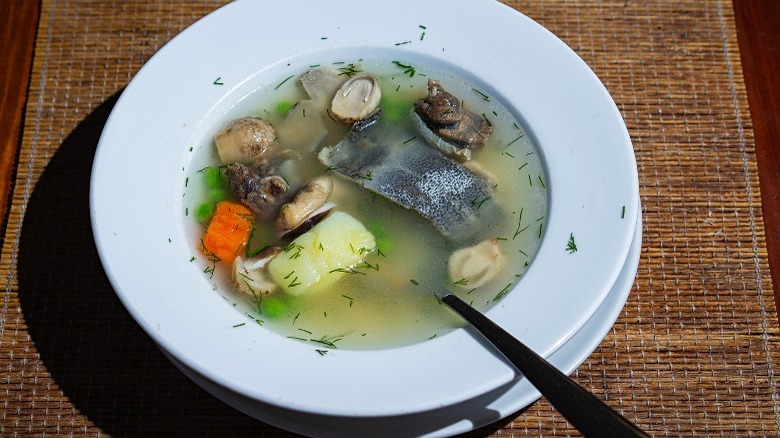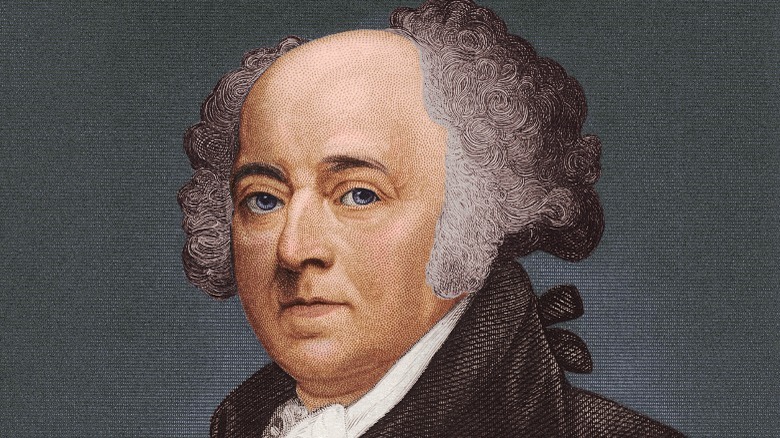America's Strangest 4th Of July Food Tradition Is Based On A Rumor
Thanksgiving may have turkey, but turtle soup was the centerpiece of the first Fourth of July cookout, or so goes the legend, anyway. It's an oft-repeated piece of trivia that John and Abigail Adams dined on the dish, which was accompanied by poached salmon, peas, and potatoes, to celebrate the signing of the Declaration of Independence. The only snag is that there's no historical evidence to truly confirm this although there was a time when Americans did indulge in turtle soup.
There is no actual record of what was on the Founding Fathers' original July 4th menu. Rather, the turtle soup rumor probably started with the fact that Chef George Lang was serving the dish at the 1964 World's Fair at Flushing Meadows Park. The menu at his Festival '64 Restaurant was heavily based on "The American Heritage Cookbook," first edition published the same year as the fair, in which authors Eleanor Noderer and Helen McCully claimed that the Adams feasted on turtle soup during the first Fourth of July celebration. A New York Times article covering the fair and Lang's restaurant pointed out the curiosity to readers all over, further spreading the legend (via Food Timeline). However, John Adams was drinking with his Patriot buddies in Philadelphia while his wife Abigail was home in Braintree, Massachusetts.
Turtles on the 4th
There was no mention of turtle soup in the letter that John Adams wrote to Abigail, describing the original July 4th celebrations across Philadelphia in 1777, a year after independence. He does note that he and his friends dined at a tavern on 2nd Street, but what they dined on remains a mystery. It's not unthinkable that turtle soup was part of the tavern's menu, though, since the dish was present in the early American diet. "The American Heritage Cookbook" may have erroneously concluded that turtle soup was an original Fourth of July specialty served by the Adams, but the recipe was based on real accounts of eighteenth- and nineteenth-century American cooking.
Turtle does have a place in the culinary history of Philadelphia, and John Adams notes in his diary that turtle was served during his time living in the city when he was attending the First Continental Congress. Aaron Burr and Alexander Hamilton were such fans of the meal that they were part of a social society called the Hoboken Turtle Club, and Abraham Lincoln celebrated his second presidential inauguration with a feast of turtle soup. Eventually, mock turtle soup with calf's head replaced the bona fide turtle as the animal became scarcer due to hunting.
So what was eaten on the 4th?
As far as the Fourth of July goes, we do know that brewskis were always a part of the tradition. According to the National Archives, John Adams noted in his letter to Abigail that revelers made toasts "in honour of our country, and the heroes who have fallen in their pious efforts to defend her." While hot dogs and hamburgers probably stem from Caribbean barbeques and the tradition of roasting a whole pig over an open fire, they aren't a true classic.
Ironic for a celebration of American independence, it's British cookbook author Hannah Glasse who can provide additional information about what may have been a part of the first Fourth of July meals. Glasse's "The Art of Cookery Made Plain and Easy" was one of the best-selling cookbooks of the 18th century, and her summer seasonal recipes hint at what was likely served at the early July Fourth parties. Meats probably included American standards like roast turkey, crawfish, and lobster — but also rabbit, pigeon, and — on the more elaborate side — tongue and turnips, and lamb testicles. Sweets may have consisted of apricot tarts, roasted apples, plums, and various custards and jellies. Still, it's not totally out of the question that an early famous American forefather was sipping on turtle broth during a Fourth of July dinner. While today, we may struggle to figure out how much watermelon to serve on the Fourth, original Independence dining was a touch more eclectic.



